
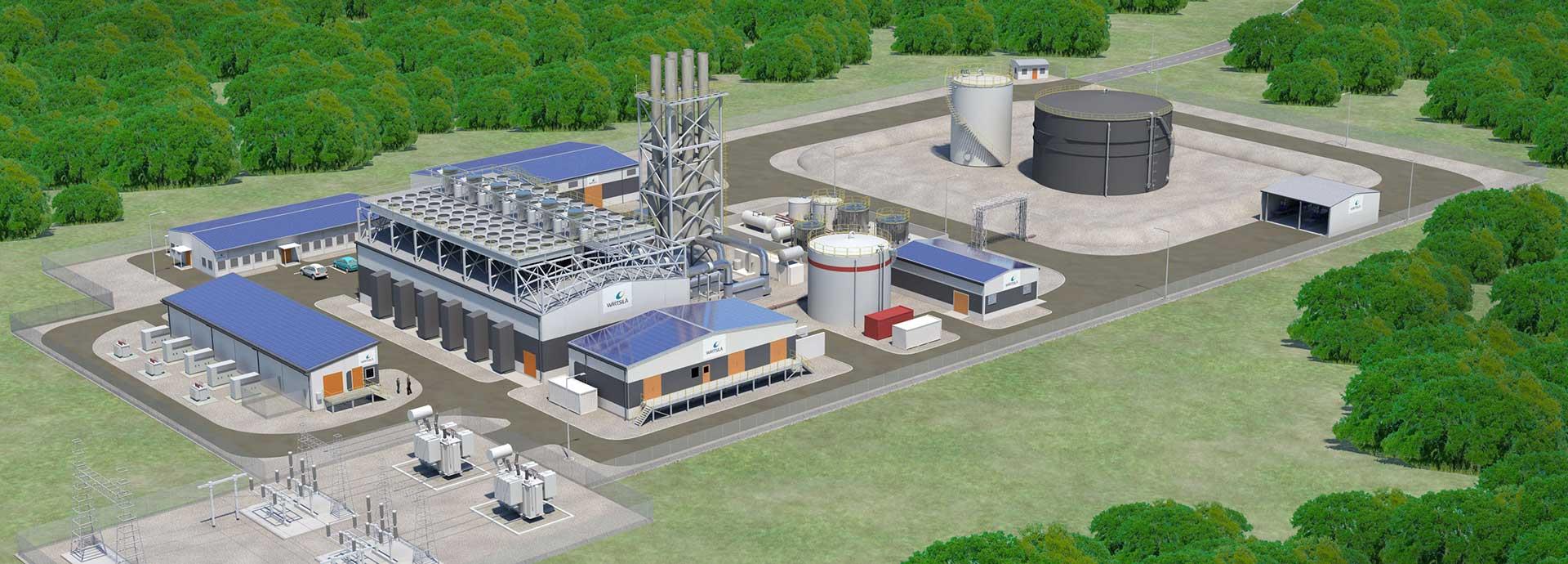
Fast-starting internal combustion engines – integrated with an energy storage battery system – provide great potential for fuel and cost savings, especially in isolated grids.
The authors of this paper studied the added value a Wärtsilä hybrid power plant (with internal combustion engines and energy storage) can provide its owners and operators in terms of economical savings and enhanced performance. The case study and simulations were made based on actual load data from an islanded industrial operation.
The hybrid power plant in question comprises six Wärtsilä 20V34DF dual-fuel (DF) engines, capable of running on natural gas, light fuel oil and heavy fuel oil, providing the plant extremely valuable fuel flexibility. The Wärtsilä 20V34DF engine delivers nearly 10 MW each with a total plant output of 58 MW. With the energy storage available in the system, the total hybrid plant capacity is 68 MW; and if solar photovoltaic (PV) generation with a performance ratio of 11 MW would be added to the system, the maximum generation capacity would be 79 MW.
As the case study is in an isolated grid, there are requirements on the generating assets to have spinning reserve capacity. For the generation units, it was selected to have contingency reserve equal to the generating unit operating at highest load and in addition also 80% of the actual solar PV generation.
Providing spinning reserve
The integrated energy storage system comprises Li-Ion batteries with peak power of 10 MW and 2.5 MWh of energy. The energy storage size was selected to be slightly bigger than the generating unit’s size, thus having sufficient capacity to provide the spinning reserve capacity equal to one unit at full load. In the case of a generating unit trip, the energy storage has the capacity to provide power for 15 minutes, which is more than enough time to start one of the standby units and take over the load.
Therefore, the energy storage can replace the spinning reserve capacity from one generation unit. In case there is solar PV generation in the micro grid, there will be additional spinning reserve requirements from the solar PV due to intermittent nature of solar generation. Hence with the selected approach, the presence of solar PV will increase the need for spinning reserve capacity.
The demand data of the industrial site including solar PV generation was simulated with the plant dispatch modelling tool PLEXOS®, a tool commonly used by utilities, consultants, system operators and regulators globally.
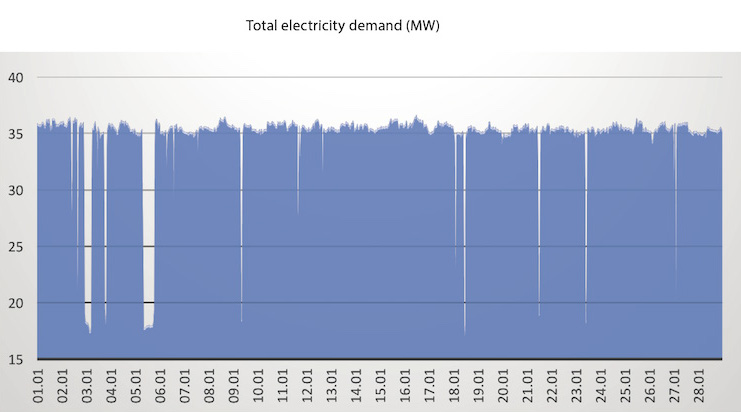
Fig. 1 - Load demand without solar generation.
30-minute resolution
The demand profile has a 30-minute resolution and the load profile for this time period is presented in Figure 1. As the grid is an isolated grid, i.e., microgrid, the demand profile equals the load that the generating units have to produce. In Figure 2, the same demand data is presented, but here also solar PV generation with a performance ratio of 30% of total demand has been included.
When evaluating the demand profile, the power need is relatively stable with a load slightly above 35 MW. It can also be noted from the profile that there are eight major events where the load is dropping rapidly with nearly 20 MW.
The trips in the system are causing additional stress on the generating units. However, it is also important to note that demand data with second resolution would be required to be able to study the real impact on, for example, frequency of these load drops.
The Wärtsilä DF engines can ramp to full load in 60 seconds and are capable of taking single load steps of 30%, giving it sufficient fast and flexible generating capacity to respond to these load changes.
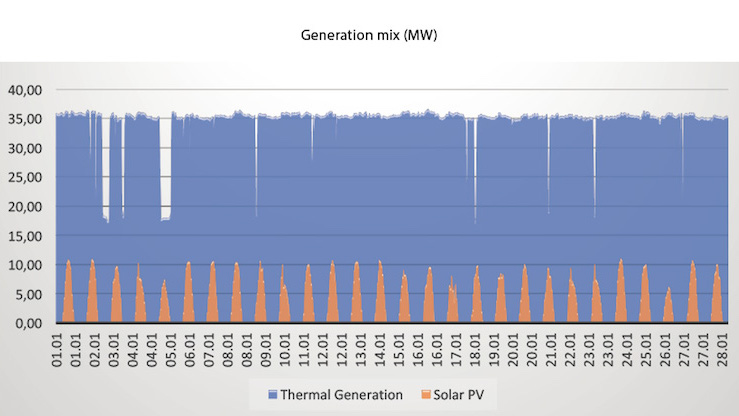
Fig. 2 - Generation mix including thermal units and solar PV production.
Strong feasibility
The feasibility of energy storage, particularly for industrial usage in isolated grids, as an integrated hybrid power plant is solid. In this study, the energy storage was only used as contingency reserve, i.e., to free spinning reserve capacity from the generating units. However, in industrial use, the energy storage could as well be used for other applications. The energy storage can e.g., act as a peaking unit and take on load steps from the isolated grid, momentarily.
The energy storage could also smoothen load fluctuations, and if stable power is required the energy storage could be used for power quality purposes to stabilise the isolated grid and hence ensure the production process for the industrial plant, eliminating production losses for the plant. (Figure 3)
What already can be seen today is that there are solid financial grounds for investing in hybrid power plants with integrated internal combustion engines + energy storage. For the energy storage, the internal rate of return (IRR) in the most feasible case was 112% and net present value (NPV) 10 MUSD. In all analysed cases, positive NPV’s and IRR’s over 30% were reached, hence there are no doubts about favourable investment decisions. Especially in remote locations, the potential enhancement that can be reached by integrating energy storage to the power plant are directly linked to the fuel prices and thus have potential to save millions on annual basis. For instance, in remote mines, factories and islands, where fuel prices are generally high, there is great potential of fully integrated and optimised hybrid power plants combining internal combustion engines, solar PV and energy storage.
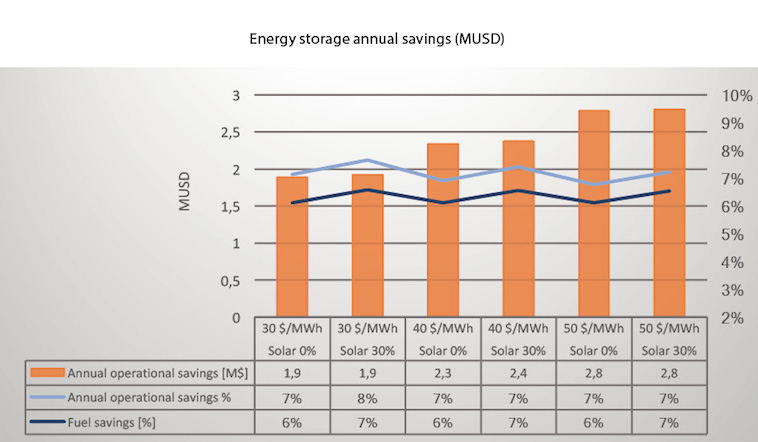
Fig. 3 - Energy storage annual savings (MUSD).
Hybrid opportunity
With the available energy storage technology and the decreasing prices of the Li-Ion batteries, the authors argue that hybrid power plants with energy storage will come strong into the future power generation markets. The possibilities to optimise the power generation by developing hybrid power plants are increasing all the time; already today it is apparent in, e.g., Europe and the USA that there are genuine interests for hybrid power plants with internal combustion engines and energy storage, integrated and optimised with an energy management system.
It should also be noted that existing power plants can be enhanced by integrating energy storage, and solar PV systems, which will improve its performance. (Figure 4)
The demand for ‘greener’ electricity production keeps rising, and this is normally achieved by adding renewable generation to the system. However, as renewable generation depends on actual wind speed or solar irradiation, flexible generation assets are a must to be able to balance the network. Hence, by optimising the thermal power plant with energy storage, the complete system can be operated at higher efficiency, and by this also the total amount of emissions can be reduced as less fuel is consumed with same amount of energy, thus providing optimised system with ‘greener electricity’.
In the study, fuel savings of 7% and annual savings of 8% were reached by adding only energy storage. For the multi-hybrid power plant, the operational savings were as high as 13%. Hence, there is a clear case also to integrate renewable generation to thermal generating systems. Also, all the generating assets shall be sized and optimised taking into account how the complete system works with the actual or forecasted load profile. By integrating all generating assets with an energy management system, the full potential of the complete system can be unleashed.
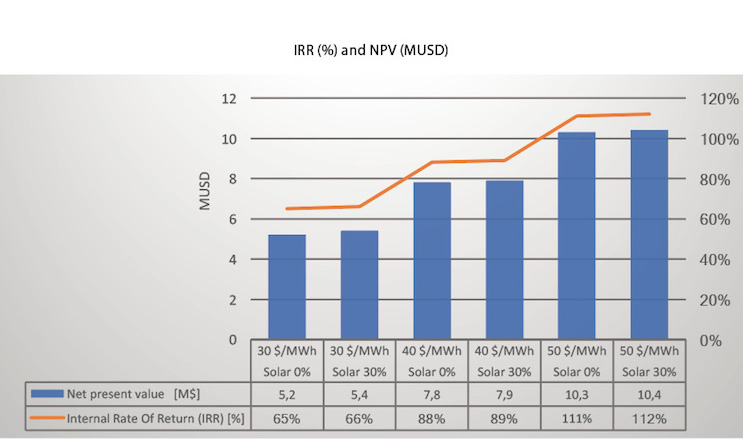
Fig. 4 - IRR (%) and NPV (MUSD).
Did you like this? Subscribe to Insights updates!
Once every six weeks, you will get the top picks – the latest and the greatest pieces – from this Insights channel by email.

